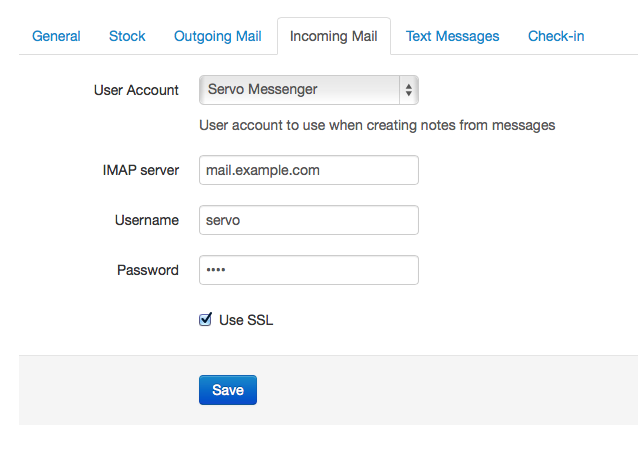Notes and Messages
Notes are basically any kind of content you enter into Servo. They are the customer's problem description, your diagnosis and repair description, helpful hints you might come across during troubleshooting, you name it.
Notes can contain any number of attachments and tags and they can also be hidden or visible in printouts.
Messages are simply notes with one or more recipients (email addresses or phone numbers).
Creating Notes
Notes can be created either from within a service order by clicking the Add Note-button or independently from the Messages-section by clicking "Create Note". While typing a note, suggestions may appear underneath the text area - these are predefined templates that your system administrator has created for quick reuse. To use a predefined note template, just type a few letters from the template and pick the appropriate suggestion.

To add attachments to a note, click on the Attachments-tab and select the files you wish to attach. Any number of files may be attached to a given note, but only 3 file inputs are shown initially (more will appear as on demand).
Labels can be used to classify and add additional meaning to notes. Access them by clicking the Labels-tab.
Sending Notes
Notes can be sent via email or SMS simply by adding email addresses and/or phone numbers to the To:field of a Note and saving it. The same note will only be sent once to the same recipients so you don't have to worry about it being sent again in case you make some changes to the note.
Formatting Notes
Servo's notes and messages support Markdown syntax allowing you to easily format your notes.
For example, to create headings, use the hash symbol (#) to signify the level of the heading (once for level 1, twice for level two, etc). The tailing hash symbol is optional:
# This is an H1 #
## This is an H2 ##
### This is an H3 ###
Links are created by surrounding the name of the link in square brackets and then the text wit the link target in parenthesis, like so:
[This link](http://example.net/)
or for example, to link to an previous Service Order:
[Previous service order](/orders/12345/)
If you just want to add a full URL, you can also use the short form:
<http://example.com>
Displaying images in a note is quite similar to using links, just remember to add an exclamation mark (!) to the beginning of the image title:

To create lists, prefix each list item with either an asterist (*) or a dash (-) symbol:
* Item one
* Item two
* Item three
To emphasize some portions of text, use double asterisks (**) around the important text:
Here's an example of a **very important ** message.
Text paragraphs are separated by a blank line, but if you just want to add a line break after a word, use two spaces after the word.
For more info and examples on using Markdown, please refer to the reference documentation.
Reading email
Servo also supports reading incoming messages via IMAP. When using this feature, incoming emails will be automatically added as notes to the service order they were sent from. Any incoming message that cannot be associated with an order will be listed under Messages > Inbox. It's a good idea to check that list every day to make sure any customer messages don't get lost, due to, for example misspelled email addresses.
Follow these steps to use this feature:
- Create a new user account that will be used to create notes from the incoming messages.
- Open System Settings > Incoming Mail
- Choose the newly created user account and fill in the remaining IMAP account details.

To have customers reply to the mailbox Servo is now reading, we must also change our Default Sender setting:
- In System Settings Click on Outgoing Mail
- From the Default Sender menu select Custom...
- Enter the email address of the user you created earlier in the text field below the menu.

Please note that users will still have the option of choosing another address as the sender when composing notes and that Servo will not track replies to those addresses.
Any attachments included in the incoming email will also be stored in the note. Servo will only consider unread messages so please keep that in mind if this mailbox is also shared with other users. The mailbox will be checked every 15 minutes.